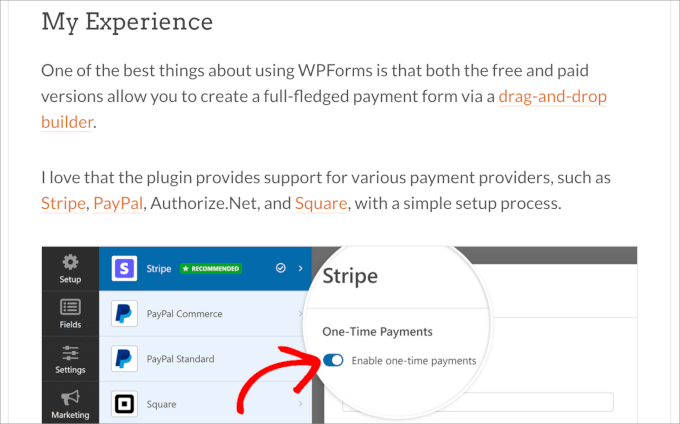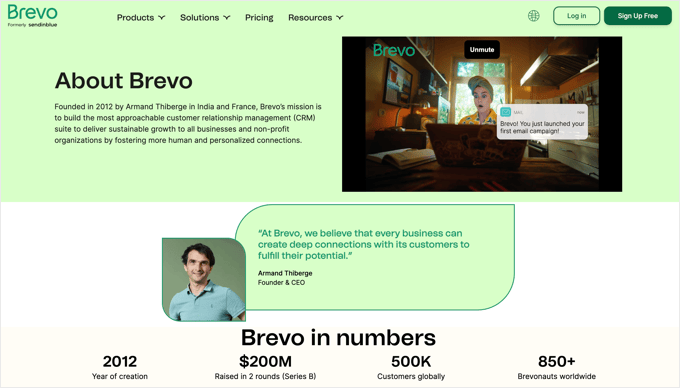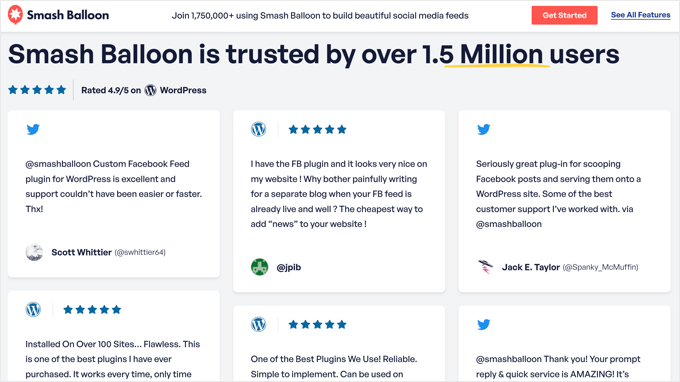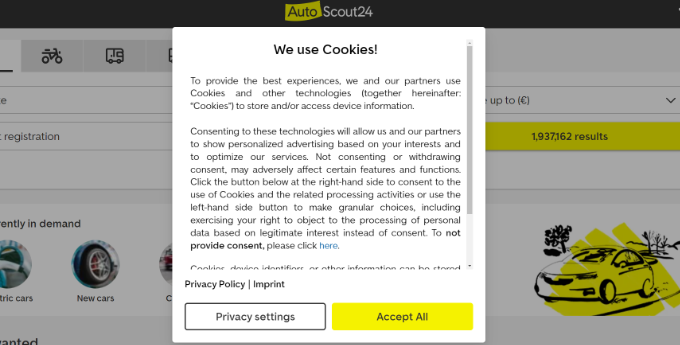[ad_1]
Are you looking to make money with affiliate marketing?
Adding compelling product recommendations to your blog content can boost your revenue by 30%. But you need to earn the trust of potential shoppers before they will click on those affiliate links.
They need to know that your website is legitimate, the products you recommend will do what you claim, your affiliate partners are above board, and they won’t lose their money through fraud.
This all comes down to brand credibility. The most successful affiliate marketers do this by establishing themselves as experts who can be trusted in a specific niche or area.
In this article, I’ll show you some of my favorite ways to build trust and make money using ethical affiliate marketing practices.
Note: This is a guest post by Blair Williams, the founder of Pretty Links, a popular all-in-one affiliate link management plugin. This is an expert column that we publish every Thursday, where we invite a WordPress expert to share their experiences with our readers.

I will cover quite a few topics in this post. Here’s a handy list so you can jump to the section you are most interested in:
Create a Professional-Looking Affiliate Marketing Site
First impressions matter. When someone first visits your website, it should give a clear signal that you are a credible source of information and recommendations. A sloppy or spammy-looking website is a huge red flag.
The best way to achieve that is to create a self-hosted WordPress blog.
That’s because WordPress is easy to use and supports a wide range of affiliate marketing tools and plugins that add the features you need.
For example, plugins like Pretty Links and ThirstyAffiliates give you a centralized affiliate link management system right in your WordPress dashboard. This saves time that you can better spend creating content and marketing your products.
You can also easily customize the look and feel of your blog using one of the best themes for affiliate marketing. These give you full control over your website’s layout and color scheme so you can match your brand and business niche.
However, if you’d like some expert help creating your site, then affordable professional website design services are also a good option.
Choose Reputable Affiliate Partners With Quality Products
In my experience, it is better to recommend a few quality products that you believe in than a huge list of products that you know nothing about.
This is one reason the average affiliate marketer only promotes 1-10 products at a time. (Source)
So, you should choose products you use yourself that come from reputable affiliate partners. Because you trust and are familiar with each product, your audience will sense your passion as they read your detailed content and personal observations.
This targeted approach lets you tailor your recommendations to the needs and interests of your audience, giving you a better chance of successful conversions.
On the other hand, promoting products you haven’t used or don’t believe in can be seen as unethical and can also damage your reputation in the long term.
Clearly Disclose Your Affiliate Relationships
One of the quickest ways to earn your visitors’ trust is to be transparent about any links you could make money from. Affiliate link disclosures are also legally required by the Federal Trade Commission (FTC) and other regulatory bodies around the world.
Disclosing where you can make money builds a bridge of trust between you and your audience.
Link disclosures should be clear and visible. You can place them near the beginning of your content or close to your affiliate links. Plus, they should be short and easy to understand.
For example, many small businesses and affiliate blogs will place an affiliate link disclosure right beneath the featured image at the beginning of each blog post.

I find that the best disclosure messages speak directly to the target audience using informal language. Personal messages will earn more trust than using a boilerplate disclaimer with legal jargon.
I also recommend creating a dedicated disclosure page on your site to show your readers that transparency is your priority. Individual link disclosures can link to this page, allowing your users to see all of your affiliate connections in one place.
WordPress affiliate plugins like Pretty Links make it easy to add an affiliate disclosure to each blog post automatically by filling in a few settings. This notice will include a link to your affiliate disclosure page.
Create Helpful Content Showing How Your Products Solve Problems
The best way to encourage your visitors to click your affiliate links is to create useful content that educates them about the value your products offer and the problems they can solve.
That content can include case studies, comparisons and reviews, tutorials, and blog posts. It can be in written or video form or a combination of the two.
I always recommend writing from your own experience and highlighting your positive and negative experiences with each product. Your content will be more credible if you talk about the methods you used to test the products along with your personal insights.
Plus, using first-person language can show your readers that you’ve actually tested out the items you recommend. Here’s an example from an affiliate review article on WordPress payment plugins:

You can also include other information that inspires trust in the product, such as usage statistics, satisfaction ratings, awards, and other data.
When you genuinely endorse products you personally use, your recommendations come across as more authentic and trustworthy. Your audience can sense your passion and genuine belief in the product’s benefits.
Creating useful content like this will help you build relationships with potential customers at each stage of their user journey, and establish you as an authority and expert in your niche.
Integrate Friendly Affiliate Links Naturally Within Your Content
Helpful content and reviews will attract new users to your website on a long-term basis. As the reader becomes convinced that the product can help them, they will be incentivized to click the affiliate links you placed within the content.
That being said, you will need to make it easy for readers to find your affiliate links.
The Wirecutter blog does this well. Their content includes helpful reviews and comparisons of products they have tested. Additionally, throughout the content, they include product boxes and affiliate links in just the right places to maximize clicks.

You can improve your click-through rate (CTR) by using links that are short, clear, and readable.
Most internet users are concerned about fraud and will immediately notice links that look suspicious. So, it’s important to use link URLs that inspire trust.
Long links can look confusing and make users hesitate or feel overwhelmed. The same goes for unreadable links that make the destination unclear.
With an affiliate link plugin like Pretty Links, you can choose to leave your links uncloaked so your visitors can see where they are going. Or you can create short links like this:
Not only is this link short and readable, but it also uses the website’s branding. This is another way to reassure users and improve the credibility of your affiliate links.
Introduce Yourself to Your Audience on Your About Page
It’s hard to trust a stranger. An About page is a great way to introduce your business to potential customers.
This page can give some details about your business, brand, and team. You can use it to outline your commitment to promoting the products you believe in and acknowledge that you participate in affiliate marketing.
Your About page is an excellent opportunity to build trust with customers by explaining how your background relates to your blog niche. The more transparent you are, the bigger the chance your visitors will do business with you.
The ‘About Brevo‘ page is a great example. They include a brief description of their history, a video of how they can help you, and a quote from the founder. They go on to include some usage statistics, introduce the team, show off their awards, and more.

By creating a similar page, you can educate potential customers about your business and position yourself as a reliable and trustworthy brand.
For more details, you can see this tutorial on how to create a custom page in WordPress.
Make It Easy for Visitors to Contact You
A well-designed Contact page is another valuable way to build trust with potential customers.
The easier it is for customers to get in touch with you, the more trustworthy you will appear. So make sure your Contact page includes a business email address, a handy contact form, and links to your social media profiles.
Customers will feel more confident about buying your recommended products if they can reach out to you with their questions and concerns.
Be sure to respond to their inquiries quickly and professionally. Take time to compose answers that are detailed and helpful, and provide additional resources where possible.
This demonstrates that you value your audience and are committed to supporting them.
Demonstrate That Others Trust You and Your Recommendations
If your website visitors are still a little uncertain, then demonstrating that other people trust your blog and your recommended products will go a long way toward reinforcing your brand’s credibility. This is called social proof.
Potential customers will feel more at ease with buying products if they know that someone else has already tried them and are happy with the result. That’s why 87% of buying decisions start with careful research.
And one of the best ways to do this is to display positive testimonials from genuine customers who have bought and used the products you recommend.
For example, you can use a tool like Smash Balloon Reviews Feed Pro to find product reviews from sites like Trustpilot, Google, and Facebook. Then, you can show the positive testimonials within your affiliate product reviews.
You can see how the Smash Balloon website uses its own plugin to display testimonials from Twitter, WordPress, and elsewhere automatically.

I also suggest asking your own readers to send you their testimonials and positive experiences with your affiliate blog. This feedback can show other visitors that your word can be trusted.
Show Your Users That You Respect Their Privacy
Many users are wary of being fooled by affiliate marketing scams and frauds. Scammers might try to take other people’s money without delivering a product, sell private user data to third parties, hijack their computers for profit, and generally show no respect for user privacy.
One common scam is ‘cookie stuffing’. This is where scammers install cookies with their affiliate tracking IDs on the computers of unsuspecting users. This allows the marketers to earn a commission whenever the users visit related websites.
Unethical tactics like this led the European Union (EU) to create the GDPR (General Data Protection Regulation) legislation. Among other things, it requires website owners to declare their use of cookies and allow users to opt out.
As a result, if you have website visitors from Europe, then you need to add a GDPR comment privacy checkbox to your site.

You can easily add a checkbox like this using a WordPress GDPR plugin.
These plugins often include a privacy policy generator that can help you set up a privacy page on your website and advise you on the type of content you should include.
I believe every website on the internet should have a Privacy Policy page. Not only does it protect your business from legal issues, but it’s also an effective way to build consumer trust.
I hope these practical tips help you build trust with your audience so you can make money with ethical affiliate marketing. You may also want to see a guide on getting a free SSL certificate to protect your WordPress visitors or the best AI chatbot software for your website.
If you liked this article, then please subscribe to our YouTube Channel for WordPress video tutorials. You can also find us on Twitter and Facebook.
[ad_2]
Source link
